The newly updated Cisco 500-220 dumps contain 57 exam questions and answers that candidates can study using the 500-220 dumps PDF and 500-220 dumps VCE to help you successfully pass the Cisco Meraki Solutions Specialist 500-220 exam.
You are welcome to download the latest Cisco 500-220 dumps: https://www.leads4pass.com/500-220.html, leads4pass 500-220 dumps serve all candidates taking the Cisco Meraki Solutions Specialist 500-220 exam and guarantee you 100% Successfully passed the Cisco Meraki Solutions Specialist 500-220 exam.
Share Latest Cisco 500-220 dumps Exam Questions and Answers for March 2023
| Type | Number of exam questions | Exam name | Exam code | Last updated |
| Free | 15 | Cisco Meraki Solutions Specialist | 500-220 | 500-220 dumps |
Question 1:
One thousand concurrent users stream video to their laptops. A 30/70 split between 2.4 GHz and 5 GHz is used. Based on the client count, how many APs (rounded to the nearest whole number) are needed?
A. 26
B. 28
C. 30
D. 32
Correct Answer: C
Question 2:
Company iPads are enrolled in Systems Manager without supervision, and profiles are pushed through Systems Manager.
Which outcome occurs when a user attempts to remove the “Meraki Management” profile on an iPad?
A. The “Meraki Management” profile cannot be removed.
B. The “Meraki Management” profile is removed and then pushed automatically by Systems Manager.
C. The “Meraki Management” profile is removed. All the profiles that Systems Manager pushed are also removed.
D. The “Meraki Management” profile is removed. All the profiles Systems Manager pushed remain.
Correct Answer: C
Question 3:
Which information is used to calculate whether a WAN link has high usage?
A. data under Security and SD WAN > Appliance Status > Uplink > Live Data
B. total historical throughput of an uplink
C. total number of devices that are actively passing traffic
D. value under Security and SD WAN > SD WAN and Traffic Shaping > Uplink Configuration
Correct Answer: D
Question 4:
Which VLAN is used to source pings across the site-to-site VPN when using the MX Live tools?
A. highest VLAN ID that is configured and set to NO to use VPN
B. lowest VLAN ID that is configured and set to YES to use VPN
C. highest VLAN ID that is configured and set to YES to use VPN
D. lowest VLAN ID configured and set to NO to use VPN
Correct Answer: C
Question 5:
Air Marshal has contained a malicious SSID.
What are two effects on connectivity? (Choose two.)
A. Currently associated clients stay connected.
B. New clients can connect.
C. Currently associated clients are affected by restrictive traffic shaping rules.
D. New clients cannot connect.
E. Currently associated clients are disconnected.
Correct Answer: DE
Question 6:
What occurs when a configuration change is made to an MX network that is bound to a configuration template?
A. The configuration change in the bound network is combined with the template configuration inside the template.
B. The more restrictive configuration is preferred.
C. The configuration change in the bound network overrides the template configuration.
D. The template configuration overrides the configuration change in the bound network.
Correct Answer: C
Question 7:
Which Cisco Meraki product must be deployed in addition to Systems Manager so that Systems Manager Sentry enrollment can be used?
A. MS Switch
B. Meraki Insight
C. MR Access Point
D. MV Smart Camera
Correct Answer: C
Reference: https://meraki.cisco.com/blog/tag/systems-manager/page/4/
Question 8:
What are two ways peers interact with ports that Auto VPN uses? (Choose two.)
A. For IPsec tunneling, peers use high UDP ports within the 32768 to 61000 range.
B. Peers contact the VPN registry at UDP port 9350.
C. For IPsec tunneling, peers use high TCP ports within the 32768 to 61000 range.
D. Peers contact the VPN registry at TCP port 9350.
E. For IPsec tunneling, peers use UDP ports 500 and 4500.
Correct Answer: AB
Question 9:
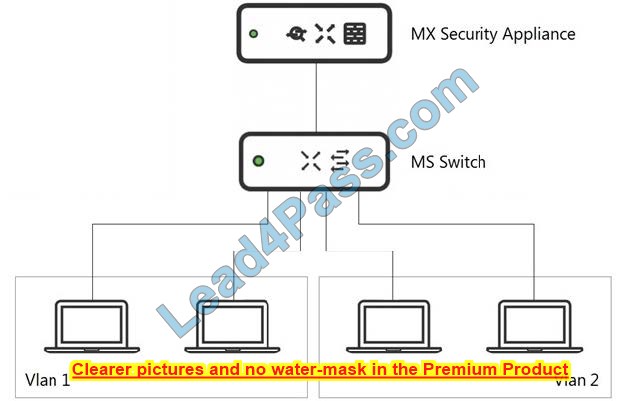
Refer to the exhibit. What is the advantage of implementing inter-VLAN routing on an MX Security Appliance rather than performing inter-VLAN routing on an MS Series Switch?
A. The MX appliance performs IDS/IPS for inter-VLAN traffic.
B. The MX appliance performs AMP for inter-VLAN traffic.
C. The MX appliance performs data encryption for inter-VLAN traffic.
D. The MX appliance performs content filtering for inter-VLAN traffic.
Correct Answer: A
Question 10:
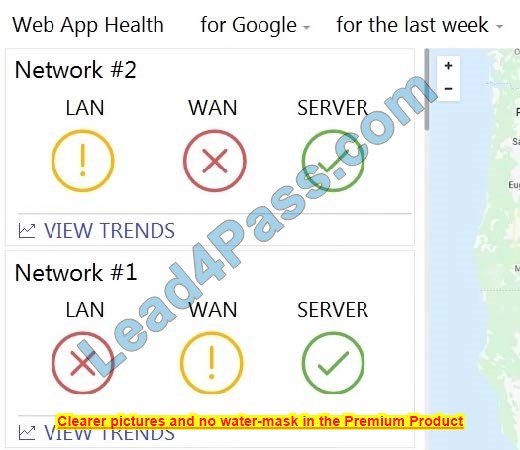
Refer to the exhibit. What are two outcomes reflected in the Web App Health application? (Choose two.)
A. Users on both networks may be experiencing issues when attempting to reach Google.
B. Network #1 could not load Google because of a remote server issue.
C. Network #2 had better application performance than Network #1.
D. Network #2 could not load Google because of a local client misconfiguration.
E. Neither network recorded any server-side performance issues.
Correct Answer: AE
Question 11:
What are two organization permission types? (Choose two.)
A. Full
B. Read-only
C. Monitor-only
D. Write
E. Write-only
Correct Answer: AB
Question 12:
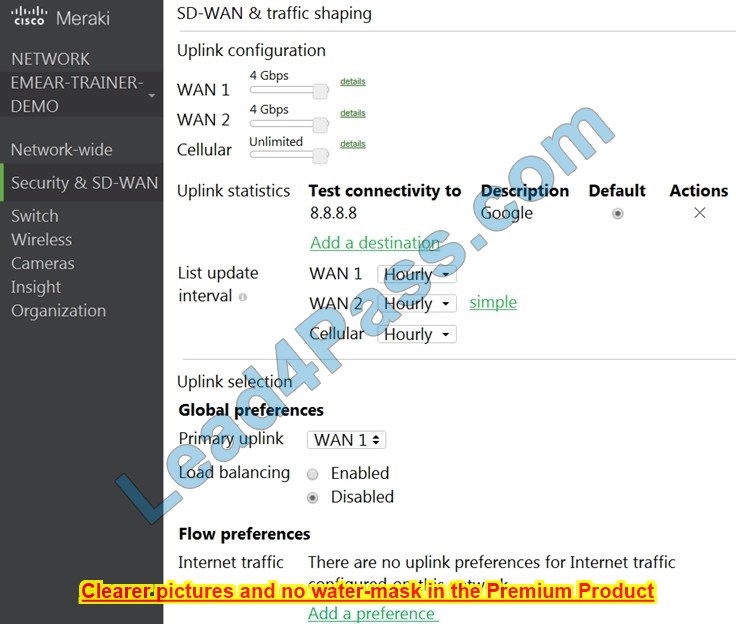
Refer to the exhibit. Which two actions are required to optimize load balancing asymmetrically with a 4:1 ratio between links? (Choose two.)
A. Change the primary uplink to “none”.
B. Add an internet traffic preference that defines the load-balancing ratio as 4:1.
C. Enable load balancing.
D. Set the speed of the cellular uplink to zero.
E. Change the assigned speeds of WAN 1 and WAN 2 so that the ratio is 4:1.
Correct Answer: CE
Question 13:
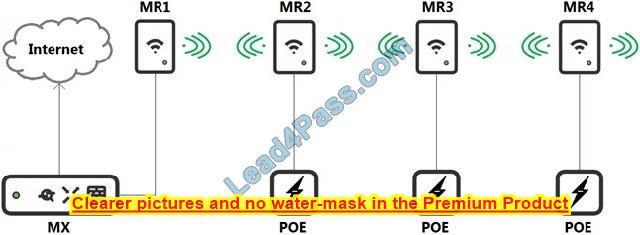
Refer to the exhibit. Which design recommendation should be considered?
A. A 25-percent throughput loss occurs for every hop. Cisco Meraki best practice recommends a 1-hop maximum.
B. A 25-percent throughput loss occurs for every hop. Cisco Meraki best practice recommends a 2-hop maximum.
C. A 50-percent throughput loss occurs for every hop. Cisco Meraki best practice recommends a 1-hop maximum.
D. A 50-percent throughput loss occurs for every hop. Cisco Meraki best practice recommends a 2-hop maximum.
Correct Answer: C
Question 14:
Which two features and functions are supported when using an MX appliance in Passthrough mode? (Choose two.)
A. intrusion prevention
B. site-to-site VPN
C. secondary uplinks
D. DHCP
E. high availability
Correct Answer: AB
Question 15:
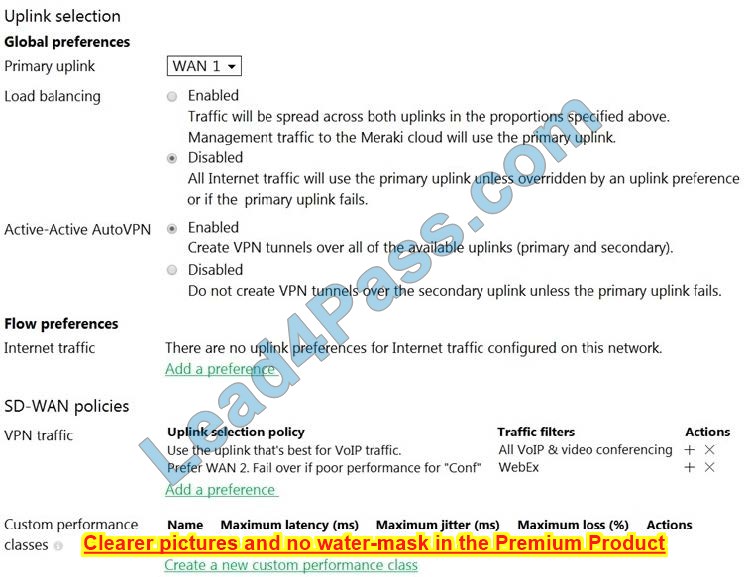
Refer to the exhibit. Assuming this MX has established a full tunnel with its VPN peer, how will the MX route the WebEx traffic?
A. WebEx traffic will prefer WAN 2 as long as it meets the thresholds in the “Conf” performance class.
B. WebEx traffic will prefer WAN 1 as it is the primary uplink.
C. WebEx traffic will prefer WAN 2 as long as it is up.
D. WebEx traffic will be load-balanced between both active WAN links.
Correct Answer: A
…
The above is only a part of Cisco 500-220 dumps exam questions and answers, you can use the above exam questions and answers to improve yourself, not only that, we welcome you to download the latest
Cisco 500-220 dumps exam questions: https://www.leads4pass.com/500-220.html (Total Questions: 57 Q&A), help you truly pass the Cisco Meraki Solutions Specialist 500-220 exam.
Comments are closed.